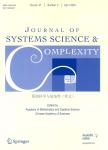How to Construct a Lower Risk FOF Based on Correlation Network? The Method of Principal Component Risk Parity Asset Allocation
作者机构:School of Management and EngineeringNanjing UniversityNanjing 210093China Postdoctoral Workstation of Bank of Jiangsu Co.LtdNanjing 210006China College of FinanceNanjing Agricultural UniversityNanjing 210095China University of Prince Edward Island550 University AveCharlottetownPE C1A4P3Canada
出 版 物:《Journal of Systems Science & Complexity》 (系统科学与复杂性学报(英文版))
年 卷 期:2024年第37卷第3期
页 面:1052-1079页
核心收录:
学科分类:12[管理学] 02[经济学] 0202[经济学-应用经济学] 1201[管理学-管理科学与工程(可授管理学、工学学位)] 020204[经济学-金融学(含∶保险学)] 0837[工学-安全科学与工程] 0714[理学-统计学(可授理学、经济学学位)] 0701[理学-数学]
基 金:supported by the Chinese National Science Foundation under Grant Nos. U1811462,71771116 the Ministry of Education Late-stage Subsidy Project for Philosophical and Social Sciences Research Foundation under Grant No. 18JHQ058
主 题:Fund of funds(FOF) mutual funds portfolio risk principal component analysis risk parity portfolio
摘 要:In order to build a low-risk Fund of Funds(FOF), from the perspective of correlation, the principal component factor is used to improve the traditional risk parity model. Principal component analysis is used to decompose the underlying assets and generate unrelated principal component factors,and then the authors can construct a principal component risk parity portfolio. The proposed empirical results based on China’s mutual fund market show that the performance of principal component risk parity portfolio(PCRPP) is better than that of equal weight portfolio(EWP) and traditional risk parity portfolio(RPP). That is to say, not only the PCRPP in this paper has much lower risk than EWP and RPP, but also slightly better than EWP and RPP in terms of average return. Moreover, the study of dividing the underlying assets shows that the PCRPP in this paper is not sensitive to the underlying assets. The PCRPP in this paper is better than EWP and RPP for both the better performing funds and the worse performing funds. In addition, the empirical results on dynamic portfolio adjustments show that it is not appropriate to adjust asset allocation too frequently when the expected rate of return is calculated using the arithmetic mean.



